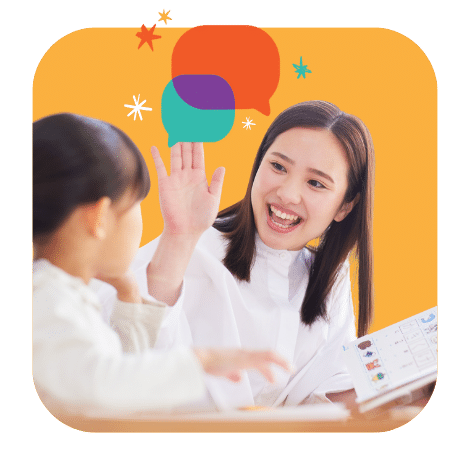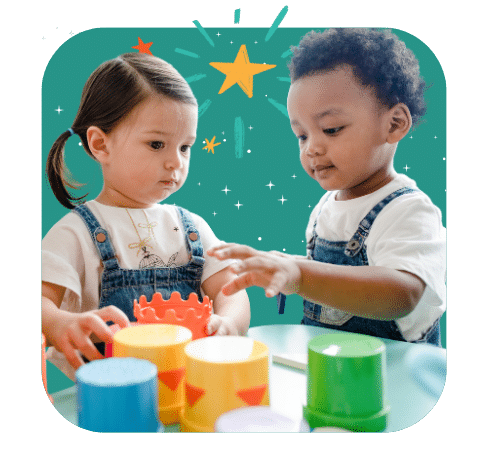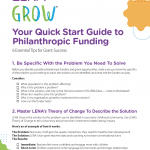Children thrive when teachers see their impact. Early childhood programs using smart early childhood assessment tools and professional development programs create classrooms where children flourish. And teachers are happier. The secret isn’t really a secret at all. It’s just assessing and measuring what actually matters.
Yet, despite billions invested in quality rating systems, 70% of children still aren’t ready for kindergarten. Programs need early childhood assessment tools that work together to capture the complete picture of quality improvement in early childhood education.
The breakthrough comes from combining two approaches. Early childhood assessment tools like CLASS® show us the big picture of classroom quality. Professional development programs like LENA Grow track the individual conversations each child experiences throughout the day. Both tools rely on research-validated data about what drives child outcomes. Both help improve classroom quality in different ways.
Smart leaders pair CLASS® with tools like LENA Grow that track each child’s personal experience. This combination shows which children get left out and helps teachers build stronger relationships. When educators can see their real impact on individual children, quality improvement in early childhood education becomes both measurable and meaningful.
Understanding CLASS®: The Gold Standard for Quality Improvement in Early Childhood Education
What CLASS® Actually Measures
If you haven’t heard of it or don’t understand what it means or does, CLASS® stands for Classroom Assessment Scoring System. Think of it as a protocol for observing how teachers and children interact throughout the day. Unlike checklists that focus on materials or room setup, CLASS® observers watch real moments. Like how a teacher responds when a child is upset, whether conversations flow naturally during activities, or how well educators help children think through problems.

The system provides a common, objective, and measurable definition of effective teaching across all age groups birth to five (they also have tools for elementary classrooms). Trained observers score interactions across different domains like emotional support, language modeling, and how well teachers extend children’s learning. Specifically, CLASS® scores show how teachers help children understand new concepts, give them useful feedback, and use rich language to build their thinking skills.
Why CLASS® Became the Standard
More than 200 research studies have shown that children in classrooms with higher CLASS® scores show better outcomes. Children develop stronger language skills, better emotional control, and higher academic achievement when their daily interactions with teachers score well.
The CLASS® system defines teaching quality through the lens of interactions and measures what matters most for children’s outcomes. It’s a journey of continuous improvement that gets teachers excited about enhancing their daily connections with kids. CLASS® works across all ages, all classroom settings, and alongside any curriculum because quality interactions drive learning everywhere.
Many states have integrated CLASS® into their quality improvement systems, as has Head Start, using it to determine star ratings and guide program self-assessment. CLASS® meets this standard by capturing the richness of educator-child relationships during observation periods.
CLASS® observations provide essential insights into classroom interaction quality. When paired with professional development programs like LENA Grow, programs get the complete picture they need to help every child thrive.
Understanding LENA Grow: Measuring Interactive Talk in Early Childhood Education Programs
The Science of Conversation
LENA Grow uses breakthrough technology to capture the actual conversations happening between teachers and children. Small wearable devices track every interaction throughout the day. And they measure conversational turns that literally shape young minds. These simple back-and-forth exchanges between adults and children form the building blocks of brain development. These are the very interactions that CLASS® focuses on, too. So what does LENA Grow bring to the table?
Proven Professional Development That Works
LENA Grow transforms children’s lives — and teachers’ lives too — through a five-week professional development program. If CLASS® shows us snapshots of classroom quality, LENA shows early education programs what’s going on moment to moment for children and teachers.
The program uses small wearable devices to measure conversations between teachers and children throughout entire days, not just during formal observations. It equips teachers with data-driven professional development that improves outcomes, both for themselves and for their children. AND it documents its own impact.
But more than all that, we agree with Dr. Amy Kronberg, Senior Manager of Early Learning Initiatives at Preschool Promise, a network of centers in Ohio: “If you don’t start with the heart of the matter, you’re missing out. And for us, the heart of the matter is teachers.”
Solving the Individual Child Experience Gap With Early Childhood Assessment Tools
The Hidden Reality in Quality Programs
Approximately one in five children in child care settings experiences language isolation —very little adult-child interaction. Even in top-rated centers.
Quality ratings paint one picture. Individual children’s experiences tell a different story.
Many children in one-star centers have very few teacher-child interactions each day. What may be surprising is that the same is true even in five-star centers! It’s particularly true for children who are shy, reserved, or speak a different language from the teacher. They are missing out on the responsive relationships with their teachers that help them grow and thrive.
Child Trends researchers put it bluntly: Quality ratings “fall short of reflecting the experiences and outcomes of the individual child.” A program can earn great scores while some children are still left out.
Two Tools, Complete Picture
The solution lies in combining approaches. Many child care quality assessments focus on a caregiver’s interactions with all children. Or just the physical environment. LENA focuses on the experiences of the individual child. CLASS® captures the classroom atmosphere. LENA reveals what each child actually experiences.
Together, they form a more complete picture of whether children are getting the responsive and instructive interactions they need. This dual approach transforms how programs operate.

Seamless Integration and Your Next Steps
How Integration Actually Works
Smart leaders don’t stop at the assessment stage. They combine a tool like CLASS® with a strengths-based professional development program like LENA Grow. They start by using CLASS® observation data to identify classrooms that could benefit most from LENA Grow. And LENA Grow doesn’t assess the teacher. Rather, it gives them the hard data that opens their eyes to how children experience their classroom.
During coaching sessions, coaches blend anecdotal CLASS® notes with quantitative LENA reports to paint a complete picture. CLASS® reveals classroom-wide patterns. LENA data does that, too. It also helps teachers set specific goals for individual children who need more interaction.
Your Opportunity Starts Now
The results prove integration works. There is strong evidence that LENA Grow works for educators across settings that use CLASS®! Not only does it prepare early educators for CLASS® observations, but there is also evidence that LENA Grow improves CLASS® scores.
Programs that can demonstrate real quality improvement have competitive advantages.
Ready to transform your approach? Start by assessing where CLASS® and interaction-focused professional development could work together in your programs. Learn more about how LENA Grow improves quality in early childhood education classrooms here!



